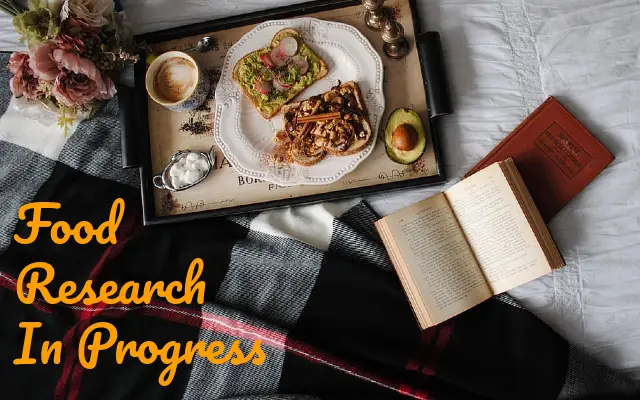
Food Research In Progress
These are the food research projects that I’m currently working on.
If you want me to prioritize any studies, let me know in the feedback form below. Also let me know if you want to collaborate on any research.
Food Research Ideas
These are sources of information that look interesting and useful. So when I get time, I will publish a review here.
- I have an idea that Pro:K might be more useful than PRAL as I develop ALKAscore as a simplified alkaline diet scoring system. So first, I’ll review these Pro:K food studies:
- Zwart, Sara R., Barbara L. Rice, Holly Dlouhy, Linda C. Shackelford, Martina Heer, Matthew D. Koslovsky, and Scott M. Smith. “Dietary acid load and bone turnover during long-duration spaceflight and bed rest.” The American journal of clinical nutrition 107, no. 5 (2018): 834-844.
- Abbasalizad Farhangi, Mahdieh, Mahdi Vajdi, and Mahdi Najafi. “Dietary acid load significantly predicts 10-years survival in patients underwent coronary artery bypass grafting (CABG) surgery.” PloS one 14, no. 10 (2019): e0223830.
- Mofrad, Manije Darooghegi, Elnaz Daneshzad, and Leila Azadbakht. “Dietary acid load, kidney function and risk of Chronic Kidney Disease: A Systematic Review and Meta-analysis of Observational Studies.” International Journal for Vitamin and Nutrition Research (2019).
- Aslani, Zahra, Maryam Bahreynian, Nazli Namazi, Nitin Shivappa, James R. Hébert, Hamid Asayesh, Mohammad Esmaeil Motlagh et al. “Association of dietary acid load with anthropometric indices in children and adolescents.” Eating and Weight Disorders-Studies on Anorexia, Bulimia and Obesity (2020): 1-13.
- Mousavi, Seyed Mohammad, Alireza Milajerdi, Memhdi Sshayanfar, and Ahmad Esmaillzadeh. “Relationship between Dietary Acid Load and Glioma: A Case-Control Study.” Qom University of Medical Sciences Journal 13, no. 1 (2019): 11-20.
- Mozaffari, Hadis, Nazli Namazi, Bagher Larijani, Nick Bellissimo, and Leila Azadbakht. “Association of dietary acid load with cardiovascular risk factors and the prevalence of metabolic syndrome in Iranian women: A cross-sectional study.” Nutrition 67 (2019): 110570.
- Milajerdi, Alireza, Ammar Hassanzadeh Keshteli, Fahimeh Haghighatdoost, Leila Azadbakht, Ahmad Esmaillzadeh, and Peyman Adibi. “Dietary acid load in relation to depression and anxiety in adults.” Journal of Human Nutrition and Dietetics 33, no. 1 (2020): 48-55.
- Emamat, Hadi, Hadith Tangestani, Zahra Bahadoran, Sajjad Khalili-Moghadam, and Parvin Mirmiran. “The associations of dietary acid load with insulin resistance and type 2 diabetes: a systematic review of existing human studies.” Recent patents on food, nutrition & agriculture 10, no. 1 (2019): 27-33.
- PRAL Score/Index
- Terms are interchangeable in practice. But I will use Index (or Scale) for articles & research about PRAL calculation (or formula). And use Score (or Value) for application of PRAL. This will involve editing older stuff. E.g. Food lists should always use Index. Potentially useful studies include:
- Wasserfurth, Paulina, Inga Schneider, Alexander Ströhle, Josefine Nebl, Norman Bitterlich, and Andreas Hahn. “Effects of mineral waters on acid–base status in healthy adults.” Food & Nutrition Research 63 (2019) (2019).
- Gore, Ecaterina, Julie Mardon, Bord Cécile, and Annick Lebecque. “Calcium lactate as an attractive compound to partly replace salt in blue-veined cheese.” Journal of dairy science 102, no. 1 (2019): 1-13.
- Fardet, Anthony, and Céline Richonnet. “Nutrient density and bioaccessibility, and the antioxidant, satiety, glycemic, and alkalinizing potentials of fruit-based foods according to the degree of processing: a narrative review.” Critical Reviews in Food Science and Nutrition (2019): 1-26.
- Wu, Tianying, Fang-Chi Hsu, Shunran Shunran Wang, and John Pierece. “Dietary Acid Load, Smoking Intensity and Total Mortality.” Current Developments in Nutrition 4, no. Supplement_2 (2020): 89-89.
- Wu, Tianying, Fang-Chi Hsu, Shunran Wang, David Luong, and John P. Pierce. “Hemoglobin A1c levels modify associations between dietary acid load and breast cancer recurrence.” Nutrients 12, no. 2 (2020): 578.
When reviewing, my text should be score or index according to my usage rules. Irrespective of the term used in the study.
Food Research Articles
These are reference sources for existing articles. As soon as I finish them, I update the relevant pages.
- Yogurt and Diabetes
- Add related article(s) based on:
Salas-Salvadó, Jordi, Marta Guasch-Ferre, Andres Diaz-Lopez, and Nancy Babio. “Yogurt and diabetes: overview of recent observational studies.” The Journal of Nutrition 147, no. 7 (2017): 1452S-1461S.
Also, any related studies. - Are Peanuts Acidic? What about Peanut Butter?
- 2 references:
-
Flavored Peanuts as Healthy as Plain
Jones, Joshua B., et al. “A randomized trial on the effects of flavorings on the health benefits of daily peanut consumption.” The American journal of clinical nutrition 99.3 (2014): 490-496. -
Peanuts Good for Arteries and Heart
Liu, Xiaoran, et al. “Acute Peanut Consumption Alters Postprandial Lipids and Vascular Responses in Healthy Overweight or Obese Men.” The Journal of Nutrition 147.5 (2017): 835-840.
-
Flavored Peanuts as Healthy as Plain
- Food Blog
- An idea to look at the science of food blogging. With a view to adopting best practices for my food blogs.
- Ho, Hui-Yi, and Pi-Hsuan Chang Chien. “Influence of message trust in online word-of-mouth on consumer behavior–by the example of food blog.” In 2010 International Conference on Electronics and Information Engineering, vol. 1, pp. V1-395. IEEE, 2010.
- Keogh, Aoife, and Barbara Chadwick. “Health food blogger: friend or foe?.” British Dental Journal 227, no. 12 (2019): 1051-1057.
- Patel, Jay. “Are bloggers blagging it?.” (2020): 22-22. doi:10.1038/s41415-019-1194-6 (Opinion on Health food blogger: friend or foe)
Note, need to also check on Nutrients Blog, Nutrition Blog, and Cooking Blog
- Recipe Traffic Light System
- My first response to researching food blogs is aimed particularly at the allegation that blogs are not responsible enough. So I had an idea that the UK system of food traffic light labeling should be applied to all recipes on my cooking blog. American adoption of traffic light labeling seems to have limited recognition:
Dunford, Elizabeth K., Jennifer M. Poti, Dagan Xavier, Jacqui L. Webster, and Lindsey Smith Taillie. “Color-Coded Front-of-Pack Nutrition Labels—An Option for US Packaged Foods?.” Nutrients 9, no. 5 (2017): 480.
However, there might be more examples. - Tomato Nutrition Facts
- Add new articles related to the Functional Food reference. Then create a summary post of diseases associated with tomato consumption. So far, found:
- Imran, Muhammad, Fereshteh Ghorat, Iahtisham Ul-Haq, Habib Ur-Rehman, Farhan Aslam, Mojtaba Heydari, Mohammad Ali Shariati et al. “Lycopene as a Natural Antioxidant Used to Prevent Human Health Disorders.” Antioxidants 9, no. 8 (2020): 706.
- Rakic, Jelena Mustra, and Xiang-Dong Wang. “Role of lycopene in smoke-promoted chronic obstructive pulmonary disease and lung carcinogenesis.” Archives of Biochemistry and Biophysics (2020): 108439.
- Eftekharsadat, Bina, Dawood Aghamohammadi, Neda Dolatkhah, Maryam Hashemian, and Halale Salami. “Lower serum levels of alpha tocopherol and lycopene is associated with higher pain and physical disability in subjects with primary knee osteoarthritis: A case-control study.” International Journal for Vitamin and Nutrition Research (2020).
- Natarajan, Tharani Devi, Janci Rani Ramasamy, and Kirthika Palanisamy. “Nutraceutical potentials of synergic foods: a systematic review.” Journal of Ethnic Foods 6, no. 1 (2019): 1-7.

Food Research In Progress
Your Food Research Ideas
Do you want me research a food topic not in my list? I can research alone or in collaboration with you. Please tell me about your food research ideas on the feedback form below.
To get email notification when I publish new food research, please subscribe:
Subscribe to Free Foodary Nexus
Subscription is free, and your email address is safe - I will never share it with anyone else. I use Gumroad to provide this service, as described at Foodary Nexus Newsletter Service.
Leave Food Research In Progress to read Shrewdies Library Home Page.
This progress page is not covered by the document revision process.
